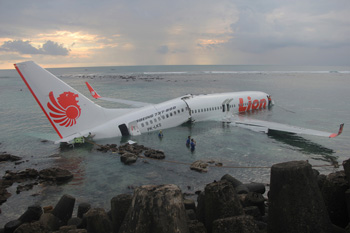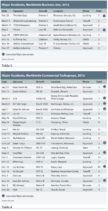
Unlike the previous two years, the worldwide commercial jet accident rate did not achieve a record low point in 2013, but it was still an excellent year for aviation safety. The 2013 commercial jet major accident rate was 0.24 accidents per million departures, which is up from 2012’s record rate of 0.14, but below 2011’s then-record rate of 0.28. The 2013 rate is the second-lowest rate ever recorded.
Unfortunately, there were two commercial jet upset aircraft accidents in 2013, the first in two years, and the return of controlled flight into terrain (CFIT) accidents continued. Four of the seven commercial major jet accidents were CFIT accidents.
Commercial turboprops also regressed slightly from their 2012 record low point in terms of number of accidents for the year. CFIT accidents again dominated the turboprop fatality numbers. Business jets had eight major accidents in 2013, an improvement from their 2012 total of 13.
There are now over 23,000 commercial jets in the world (Table 1). Of these, approximately 4 percent are Eastern built, and 17 percent of the world’s commercial turboprop fleet is Eastern built. The commercial jet inventory grew about 2.5 percent from 2012, while the commercial turboprop inventory decreased about 2 percent. The business jet inventory grew 2 percent from the previous year. Thus, for the first time in many years, the leaders in growth were commercial jets, not business jets.
The numbers in Table 1 reflect the total fleets. The numbers of active aircraft, the aircraft actually in use, are somewhat smaller. Approximately 8 percent of the commercial jet fleet is inactive, including almost 40 percent of the Eastern-built commercial jets. Approximately 14 percent of the turboprop fleet is inactive. For the third year in a row, there were inactive business jets, with 3.5 percent of the inventory inactive.
Table 2 shows the major accidents that occurred in 2013 for all scheduled and unscheduled passenger and cargo operations for Western-built and Eastern-built commercial jet aircraft. Five of the seven accidents happened during the approach and landing phase of flight. As mentioned, four of the seven were CFIT accidents, and there were two upset aircraft accidents.
Figure 1 shows the total number of commercial jet major accidents and the number of Eastern-built aircraft accidents for commercial jets since 2002. Over the last five years, an average of 5 percent of the active commercial jet fleet was Eastern built, but they accounted for 30 percent of the major accidents over that same period. There were no Eastern-built commercial jet major accidents in 2013.
Figure 2 shows the commercial jet major accident rates and the five-year running average. This rate is only for Western-built jets because, even though we know the number of major accidents for Eastern-built jets, we do not have reliable worldwide exposure data (hours flown or departures) to calculate valid accident rates. After a decade of negligible improvement in the accident rate for commercial jets, a very positive trend of improvement that started in 2011 is evident, and the five-year running average continues to decrease.
The eight major accidents for business jets in 2013 (Table 3) were below their 12-year average of 10.5. As with Eastern-built aircraft, calculating accident rates for business jets is difficult due to the lack of reliable exposure data. One rate that can be calculated is the number of major accidents per 1,000 aircraft. Figure 3 (p. 22) uses this metric, and it shows an improvement in the business jet accident rate over the last nine years.
Table 4 lists the major accidents involving Western-built and Eastern-built commercial turboprop aircraft with more than 14 passenger seats. The 22 major turboprop accidents in 2013 are about average, and above the record low of 17 set in 2012. Figure 4 shows the number of turboprop accidents since 2002. CFIT accidents continue to dominate the accident and fatality numbers for commercial turboprops. In 2013, eight of the 22 major accidents were CFIT accidents. Over the last seven years, 30 percent of the commercial turboprop major accidents have been CFIT accidents.
CFIT, approach and landing, and upset aircraft accidents continue to account for the majority of accidents and cause the majority of fatalities in commercial aviation. Of the seven commercial jet major accidents in 2013, five were approach and landing accidents. Over the last five years, 70 percent of commercial jet major accidents have been approach and landing accidents. Figure 5 shows the CFIT accidents for all commercial jets since 1999. The upward trend since 2009 is quite disappointing because more than 95 percent of all commercial jets have been equipped with TAWS (terrain awareness and warning systems) since 2007. Over the previous six years, there have been 38 commercial aircraft CFIT accidents (14 turbojet, 24 turboprop). Only three of these 38 aircraft were equipped with an operating TAWS. In those three aircraft, the TAWS provided 30 seconds or more of warning of the impending collision with the ground. In the last two years, over 50 percent of the commercial jet fatalities have been caused by CFIT accidents. In 2006, upset aircraft accidents took over from CFIT as the leading killer in commercial aviation. Over the last three years, commercial jets have suffered 11 CFIT accidents and two upset aircraft accidents. Because of this, and the number of CFIT accidents involving turboprop aircraft, CFIT is poised to regain its title as the leading killer in commercial aviation.
Upset aircraft accidents continue to be one of the leading killers in commercial aviation. After having no upset aircraft accidents since May of 2010, airlines had two in 2013, as noted. There are numerous international efforts under way to reduce the risk of upset aircraft accidents, and the recent decrease in upset accidents indicates these efforts may be having some success.
The classification term major accident was introduced in 2006 by Flight Safety Foundation and means that any of the following conditions are met:
- Aircraft destroyed. (Destroyed means the aircraft is not repairable, or if it is repairable, the Ascend Damage Index (ADI) is over 50 percent. The ADI is calculated by dividing the cost of repairs by the cost of the aircraft when it was new.)
- Multiple fatalities to aircraft occupants.
- One fatality to an aircraft occupant and aircraft substantially damaged.
These criteria ensure that an accident classification is not determined by an aircraft’s age or its insurance coverage, and they give a more consistent and accurate picture of consequential accidents.
James M. Burin, former FSF director of technical programs, is a Foundation fellow



